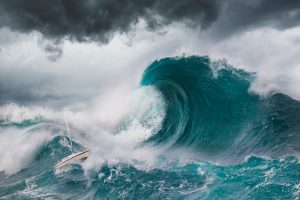Rogue Waves
By Michael FaginGeneral InfoWith 0 commentsRogue Waves – also known as episodic, abnormal, extreme, freak, monster and killer waves – are more than twice the average height of the tallest third of a region’s waves. The threat, posed in oceans and large lakes, appears unexpectedly swiftly, can be responsible for thousands to millions in damages and claim dozens of lives. Lore has suggested their existence for millennia but they weren’t affirmatively proven to exist until the 1980s and 90s. Even in modern times, the giant walls of water are believed to be a primary cause of the loss of supertanker and container ships, which are designed to withstand ferocious storms.
Tsunamis are distinct from rogue waves in that they’re caused by seismic movements of the ocean floor and the corresponding displacement of water. Such tidal waves don’t pose a threat to vessels far from shore because they remain underwater until the slope that leads to the shoreline pushes them upward.
The advancement of recording technologies this century has led to the circulation of several videos of rogue waves striking ships, as seen on YouTube. The tallest observed by humans was 95’, endured in the year 2000 by Britain’s RRS Discovery. Slopes of water that tall – breaching five times the average sea height – are known as super rogue waves.
Rogue Waves Unpredictable.
Presently, they are almost unpredictable. The nonlinear, non-Gaussian math involved in their manifestation has masked the underlying elements essential to creating a theory that satisfactorily explains their appearances. The conditions necessary for their formation, however, are known: strong currents, high winds and other intense pulls and pushes on the water. Often, they are preceded by relatively calm conditions. Multiple wind-generating forces can add together to create constructive interference, which piles displaced water. Researchers at MIT recently released an algorithm designed for the computing power of a typical laptop computer that boasts a 2-3 minute rogue wave warning for ships at sea.
Assessing the weather’s role in damaging or sinking nautical vessels is a separate task undertaken by forensic meteorologists. It will be a long while yet before the ship insurance companies that inspect and classify vessels mold their policies around the knowledge of the mechanics of rogue waves obtained by the past couple generations of scientists and mathematicians.
Satellite radar measurements have revealed that rogue waves occur in all five oceans. It has been estimated that, at any given moment, ten exist that are over eighty feet tall. Rough calculations suggest a probability of 0.03% that a wave deep at sea will, over its lifetime, become a rogue wave. They appear roughly ten times as often around inlets and river mouths, where currents are amplified and naval traffic may be frequent.
Written by Meterloglist Geoff Linsley

